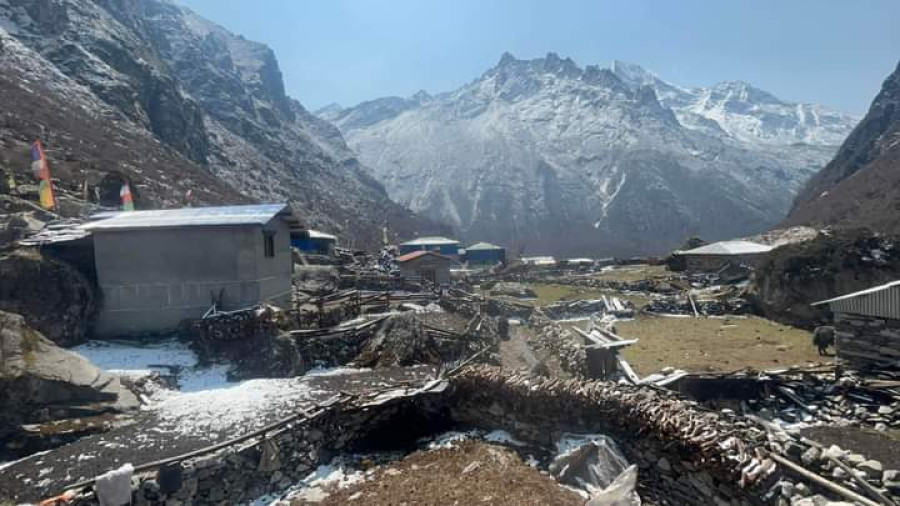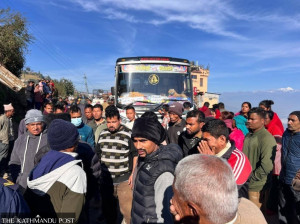Bagmati Province
Tibet border reopening provides relief to Nepal villagers
The Nepal-China border point at Lapchi in Dolakha has reopened for the residents of Lapchi to trade in Tibetan markets.
Kedar Shiwakoti
The locals of Dolakha’s Lapchi village in ward 1 of Bigu Rural Municipality near the Nepal-China border have heaved a sigh of relief after the Chinese authorities eased cross-border movement for the residents of the border village.
The locals were allowed to cross over to Tibet to trade their goods in the markets across the border after the Chinese authorities opened the border for Lapchi residents on September 30.
Lapchi locals rear yaks and produce yak milk products to sell in the Tibetan markets across the border. Since the border closure in 2019 during the Covid pandemic, the locals had been unable to sell their goods in the Tibetan market, cutting their incomes significantly.
Trade in the Tashighang market is the mainstay of the Lapchi locals. They rely heavily on the Tibetan market for trade and for everyday essentials from food items to other household requirements. They had been requesting the Nepali authorities to open diplomatic channels with China to open the Lapchi border.
Since the ease of cross-border movement, the locals have sold more than 350 yak calves and around 12,000 kgs of yak ghiu (butter) in Tashighang market in Tibet, according to 44-year-old Lapchi local Temba Sherpa, who had crossed the border to trade.
“We went to Tashighang market after almost five years to sell yak calves and yak ghiu,” said Temba, who returned from the Tibetan market a few days ago. “The market has changed. A lot of development is underway. We sold some ghiu and cattle and bought food items like grains and salt. We can never be sure when the authorities will seal the border again.”
According to Temba, the Chinese authorities have eased border movement for the locals of border areas to buy yak calves and yak milk products from Nepali traders to meet the demand for the same in the Tibetan market. “We managed to generate some income, but the market price of our products has decreased. Earlier we would sell yak ghiu for Rs1,600 per kg, but this time we could not get more than Rs1,400. We sold yak calves for Rs5,000 each which is less than the price we received before the pandemic,” said Temba.
Karma Sherpa, a 49-year-old man from Lapchi village, said the villagers could not sell all the yaks they had been rearing for sale. “We had more than 700 yaks ready for sale. We could sell only half of them,” said Karma.
There are two border pillars—pillar number 55 and 56—in the Lapchi area. It takes an hour and a half for Lapchi locals to reach Chupsang in Tibet from the border. From here, a three-hour bus ride takes one to Tashighang market. The Chinese government had closed the border after the 2015 earthquake, but it was opened for residents of bordering villages later. The border was closed again in 2019. The prolonged border closure had made life difficult for the residents of bordering Nepali villages. Most Lapchi locals have already migrated elsewhere seeking other income sources.
The village earlier had 48 households with around 150 people. Of late, only around 12 to 13 families had remained. The locals of Lapchi had to walk for two days to reach Lamabagar in ward 1 of Bigu to buy food essentials. They had to pay up to Rs140 per kg to get the goods transported to the village. Since the ease of border movement, some of the natives of the village have started to return, said Karma.
Citing difficulties in selling their goods in Nepali markets given the geographical difficulties and the distance, Karma says they would go back to Tashighang to sell more yaks and yak butter.
“We will go back to Tashighang if there is more demand for our yaks and yak milk products,” said Karma. “The border can close any time so we are trying to trade as much as possible. We have more yak ghiu in stock so if the demand in the Tashighang increases, we will go again.”
According to Karma, the locals of Lapchi and Tashighang share more than just a trade relationship. “Most families have relatives through marriage on the Tibetan side. Some of them went there to meet their relatives. Marriages have taken place between the people of the two villages throughout history and we find similarities in our cultures as well. That’s why it’s important to keep the border open for movement for the benefit of people from both sides.”
The Chinese authorities have allowed only Lapchi locals to cross over to Tibet for now, according to Chief District Officer Komal Prasad Dhamala. “We have written to the Chinese authorities to open the border officially for cross-border movement of the people on both sides. For now, border movement has been eased only for Lapchi locals,” he said. “We had informed the Chinese authorities about the financial difficulties Lapchi locals faced due to the border closure. But this is only a temporary solution. We are working towards keeping the border open like how it was before the pandemic.”




 14.12°C Kathmandu
14.12°C Kathmandu














